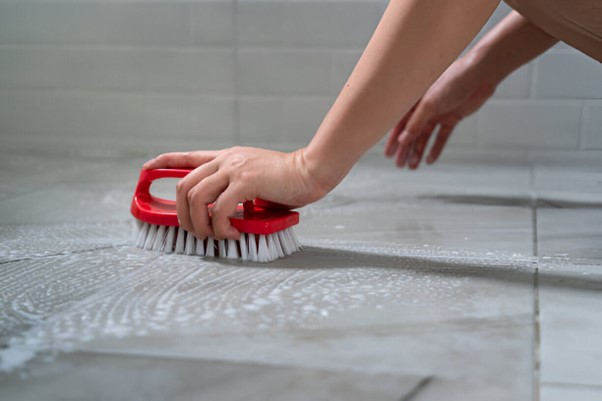Soap scum is an unsightly and stubborn residue that can dull the shine of your tiles and make them look unclean. Over time, it builds up on bathroom and kitchen tiles, especially in areas with hard water.
Fortunately, with the right techniques and tools, you can easily remove soap scum from tile surfaces and restore their sparkle. Let’s dive into the most effective methods.
Table of Contents
What Causes Soap Scum?
Soap scum forms when soap combines with hard water minerals, creating a film that clings to tile surfaces. Over time, this residue can weaken the protective coating on tiles, making them more susceptible to damage and stains.
Additionally, the buildup can harbor bacteria and mold, posing potential hygiene risks in bathrooms and kitchens. This film can attract dirt and bacteria, making it a health concern as well as an aesthetic issue.
Over time, it accumulates and becomes more difficult to remove. Understanding how soap scum develops is the first step to effectively removing soap scum from tile surfaces.
Methods to Remove Soap Scum from Tile
1. Vinegar and Baking Soda Solution
One of the simplest and most eco-friendly solutions to tackle soap scum is using a mixture of vinegar and baking soda. Vinegar, with its acetic acid, breaks down mineral deposits and soap residue while baking soda provides gentle abrasion to scrub away the loosened buildup effectively.
This combination not only cleans but also deodorizes, leaving your tiles refreshed.
Begin by mixing equal parts of white vinegar and water in a spray bottle. Spray this solution generously over the soap-scum-affected tiles and let it sit for 15 minutes. The acidic properties of vinegar break down the mineral buildup and soap residues effectively. Afterward, sprinkle baking soda on a damp sponge and scrub the tiles thoroughly. Baking soda acts as a gentle abrasive to remove the loosened scum without scratching the surface. Finally, rinse the tiles with clean water and dry them with a soft cloth to prevent streaks and water spots.

2. Commercial Soap Scum Removers
When natural remedies aren’t enough, commercial soap scum removers can provide an efficient solution. Select a non-abrasive cleaner formulated specifically for soap scum removal.
Apply it evenly across the tiles and follow the instructions provided by the manufacturer. Use a soft-bristled brush to gently scrub the affected areas, ensuring the scum lifts without damaging the tile surface.
Rinse thoroughly with warm water to remove any residual cleaner and dry with a microfiber cloth to restore the tile’s original shine. this step is generally overlooked by many homeowners, so make sure you don’t fall for such tile cleaning mistakes.
3. Lemon Juice and Salt Scrub
Harnessing the natural power of lemon juice and salt is another effective way to combat soap scum.
Lemon juice, with its high citric acid content, breaks down the mineral deposits and soap residue that form soap scum.
Salt acts as a mild abrasive, scrubbing away the loosened buildup without damaging the tiles. This combination is not only effective but also leaves your bathroom with a fresh, natural scent.
Cut a fresh lemon in half and dip the cut side into table salt. Use the salted lemon to scrub the tiles, allowing the natural acidity of the lemon juice to break down soap scum while the salt provides gentle abrasion.
Allow the solution to sit on the tiles for about 10 minutes, then rinse thoroughly with warm water. This method not only cleans but also leaves a refreshing citrus scent in the room.
4. Hydrogen Peroxide and Baking Soda Paste
For tiles with stubborn soap scum buildup, hydrogen peroxide, and baking soda paste can be highly effective. Combine the two ingredients to form a thick paste and apply it directly to the affected areas.
Let it sit for 15 minutes to penetrate the buildup. Scrub the area with a soft sponge, focusing on heavily stained spots. Rinse thoroughly with clean water and pat dry. This method is particularly beneficial for tiles that haven’t been cleaned for an extended period.
Tips for Preventing Soap Scum
- Switch to Liquid Soap: Bar soaps often contain talc and fats, which contribute to soap scum. Using liquid soap or shower gel can help minimize residue.
- Squeegee After Every Shower: Regularly removing water from tiles with a squeegee helps prevent mineral deposits and soap residue from accumulating.
- Install a Water Softener: Hard water accelerates soap scum formation. Installing a water softener reduces mineral content and minimizes buildup.
- Regular Cleaning Routine: Cleaning tiles weekly with mild detergents keep surfaces clear of grime and soap residue.
- Apply a Tile Sealer: Using a tile sealer provides a protective layer that repels soap scum, making cleaning easier and less frequent.
- Ventilate the Bathroom: Adequate ventilation reduces moisture levels, preventing conditions that encourage soap scum buildup. Open windows or use an exhaust fan during and after showers.
Conclusion
Soap scum can significantly diminish the appearance of your tiles, but it doesn’t have to be a permanent issue. Using natural solutions like vinegar and baking soda, commercial cleaners for tougher stains, or innovative methods such as hydrogen peroxide paste, you can tackle even the most persistent soap scum.
These techniques, combined with regular maintenance and preventative tips like using a squeegee or applying tile sealers, will help keep your tiles looking spotless. By following these effective cleaning methods and adopting preventative measures, you can keep your tiles sparkling clean.
If stubborn soap scum persists despite your best efforts to remove soap scum from tile surfaces, such as in cases where grout is heavily stained or the buildup has hardened over time, it may be time to consult a professional cleaning service, trust JP Carpet Cleaners, their experts have specialized tools and techniques to effectively remove soap scum and restore the beauty of your tiles.

